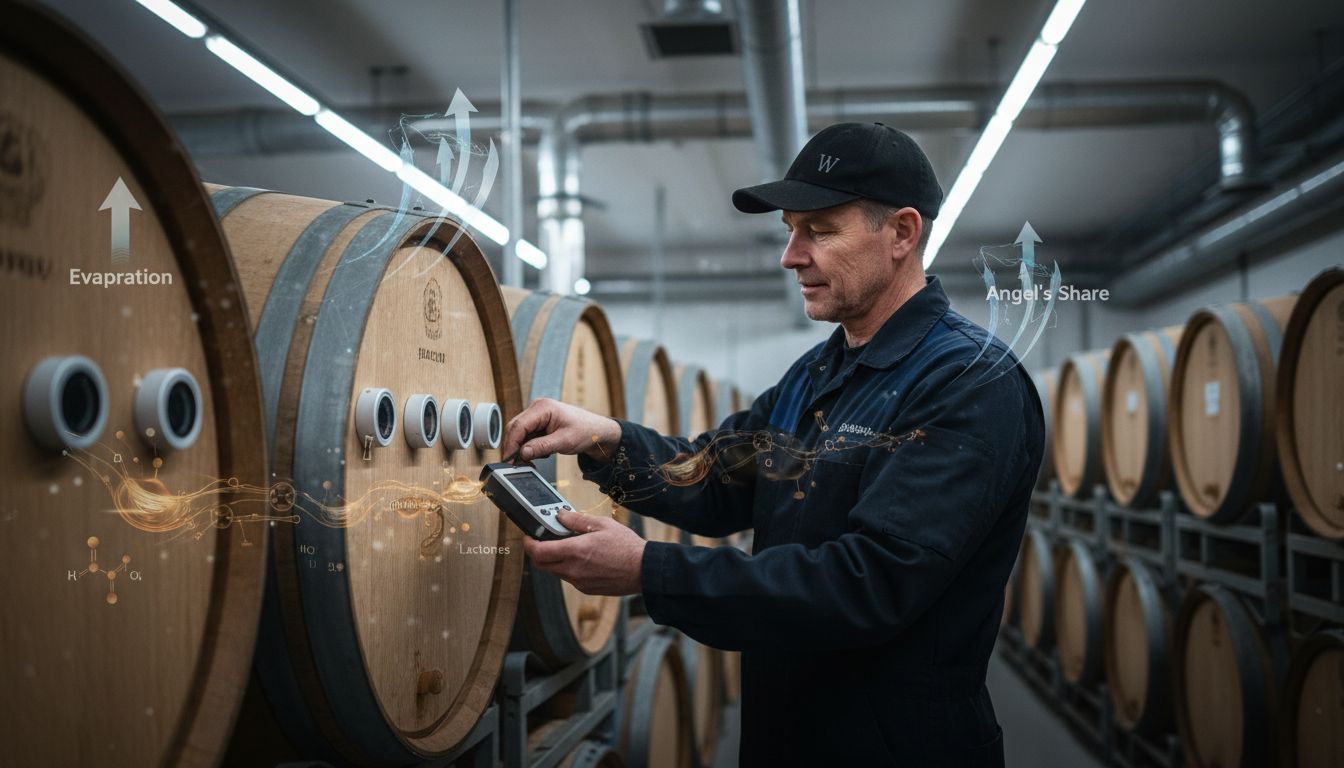Did you know that nearly 70 percent of a whisky’s final flavor comes from its time in a cask? Whisky aging is not just about waiting for years to pass. The secret lies in a mystical interaction between spirit, wood, and environment. Curious drinkers often wonder how raw alcohol transforms into complex sips with aromas of vanilla, spice, and fruit. Understanding why whisky is aged will help you appreciate every glass on a whole new level.
Table of Contents
- Why Whisky Is Aged: Key Concepts Explained
- The Role of Casks and Maturation Environments
- How Aging Transforms Flavours and Aromas
- Legal Standards and Global Aging Requirements
- Common Myths and Mistakes About Whisky Aging
Key Takeaways
| Point | Details |
|---|---|
| Importance of Aging | Whisky maturation in wooden casks is essential for developing unique flavors and smoothing harsh alcohol notes. |
| Cask Influence | The type of cask and environmental conditions greatly affect the whisky’s final flavor profile. |
| Legal Aging Standards | Different regions enforce minimum aging periods, ensuring quality and consistency in whisky production. |
| Myths of Aging | Common misconceptions include the belief that older whisky is always superior and that whisky continues to mature in the bottle. |
Why Whisky Is Aged: Key Concepts Explained
Whisky aging is a fascinating transformation process that turns raw distilled spirit into a complex, nuanced beverage. According to research from whisky investment experts, maturation in wooden casks is essential for developing the spirit’s distinctive flavor and character. During this intricate process, the whisky undergoes multiple interactions with the wooden barrel, creating a sensory experience that goes far beyond simple storage.
The aging process involves several critical chemical interactions between the whisky and the wooden cask. As studies indicate, these interactions include extraction, evaporation, oxidation, concentration, filtration, and coloration. Each of these processes contributes unique characteristics to the final product. The wood gradually imparts subtle flavors like vanilla, caramel, and woody notes while also helping to smooth out the harsh edges of the original spirit.
Key transformations occur during whisky aging that fundamentally change its profile:
- Softening of harsh alcohol flavors
- Development of rich, complex taste notes
- Absorption of color and subtle wood characteristics
- Gradual concentration of flavors through evaporation
For enthusiasts wanting to explore more regional nuances, check out our guide to Japanese whisky styles, which offers deeper insights into how different traditions approach this remarkable aging process.
The Role of Casks and Maturation Environments
The cask represents far more than a simple storage container in whisky production - it is a critical instrument that fundamentally shapes the spirit’s character. According to research from The Glenlivet, the type of cask, including its wood type, size, and previous contents, significantly influences the whisky’s final flavor profile. Different wood varieties like American oak, European oak, or sherry-seasoned casks each contribute unique flavor nuances and complexity to the aging spirit.
Environmental factors play an equally crucial role in whisky maturation. As studies from the Scotch Malt Whisky Society highlight, warehouse environments such as dunnage, racked, and palletized warehouses dramatically impact the aging process. Temperature fluctuations and humidity levels within these spaces can accelerate or slow down maturation, creating subtle variations in flavor development. Some distilleries carefully control these conditions to achieve consistent, exceptional results.

Key factors affecting cask and environment interactions include:
- Wood type and previous cask contents
- Warehouse storage method
- Temperature and humidity variations
- Duration of maturation
- Geographical location of the warehouse
For whisky enthusiasts eager to explore specific regional variations, our guide to Macallan’s Double Cask range offers insights into how specialized cask techniques can transform a whisky’s character.
How Aging Transforms Flavours and Aromas
Whisky aging is a complex chemical dance that transforms a raw spirit into a nuanced beverage. According to research from Rare Malts & Co, the process involves intricate chemical interactions between the whisky and the wooden cask, fundamentally altering its sensory profile. During maturation, several key processes work together to create the rich, complex flavors whisky enthusiasts cherish.
The aging journey involves four critical transformative processes. As studies from Whisky’s detailed research indicate, these include oxidation, evaporation (famously known as the ‘angel’s share’), extraction, and integration. Oxidation softens harsh alcohol notes, while extraction draws complex compounds from the wooden cask. The ongoing evaporation concentrates flavors, creating deeper, more intense taste experiences. Warehouse conditions like temperature and humidity further influence these delicate transformations.
Here’s a comparison of the four key flavour-transforming processes during whisky maturation:
| Process | Role in Ageing | Key Outcomes |
|---|---|---|
| Oxidation | Softens harsh alcohol notes | Smoother, mellow profile |
| Extraction | Draws compounds from wood | Vanilla, caramel, tannins |
| Evaporation | Removes water, alcohol | Concentrated flavours |
| Integration | Blends spirit and wood notes | Balanced, complex aromas |
Key flavor development mechanisms include:
- Gradual absorption of wood-derived compounds
- Softening of harsh spirit characteristics
- Concentration of flavor through natural evaporation
- Development of subtle aromatic notes
- Chemical interactions that smooth and balance the spirit
To explore how different cask techniques impact whisky character, check out our guide to Scotch whisky definitions, which offers deeper insights into traditional maturation practices.
Legal Standards and Global Aging Requirements
Whisky aging is not just an art but a regulated process with specific legal standards varying across different regions. According to research from Wikipedia, the minimum aging periods differ significantly between countries, creating unique regulatory landscapes for whisky production. These legal requirements ensure consistency, quality, and traditional production methods that protect the integrity of each regional whisky style.
In most major whisky-producing countries, there are strict minimum maturation periods. As The Glenlivet’s research highlights, Scotch whisky requires a minimum of three years of cask aging, while straight bourbon in the United States must be aged for at least two years. These regulations are not just bureaucratic formalities but critical quality control measures that guarantee a certain standard of flavor development and spirit refinement.
Key global aging requirements include:
- Scotland: Minimum 3 years in oak casks
- United States: Minimum 2 years for straight bourbon
- Ireland: Minimum 3 years of maturation
- Canada: Minimum 3 years aging period
- Japan: Follows similar standards to Scotch whisky regulations
For enthusiasts wanting to dive deeper into regional whisky distinctions, our guide to understanding the difference between whisky and rye offers comprehensive insights into the nuanced world of spirit classifications.
Common Myths and Mistakes About Whisky Aging
Whisky enthusiasts often fall prey to several persistent misconceptions about the aging process. According to Whisky Genius research, one of the most widespread myths is that older whisky is always superior. In reality, excessive aging can lead to over-oaking, where wood flavors become so dominant that they completely overwhelm the spirit’s original character, resulting in an unbalanced drinking experience.
Another critical misunderstanding involves the belief that whisky continues to mature after bottling. The Glenlivet’s research definitively clarifies that once a whisky is bottled, its flavor profile becomes static. Maturation occurs exclusively during the cask-aging period, and once the spirit is removed from wooden barrels, no further flavor development takes place. This means that a 12-year-old whisky will remain precisely the same whether stored for 1 year or 20 years after bottling.
Common whisky aging myths include:
- Older whisky is always better
- Whisky continues to mature in the bottle
- All wooden casks produce identical flavor profiles
- Aging time is the only factor determining whisky quality
- Expensive whiskies are inherently superior to less costly options
For whisky enthusiasts seeking to deepen their understanding of nuanced spirit selection, our guide to choosing single malt whisky offers expert insights into making informed purchasing decisions.
Discover the True Art of Whisky Aging with Uisuki
Understanding the magic behind whisky aging unlocks a world of flavour and character that every enthusiast craves. If you have ever wondered how different cask types and maturation environments transform whisky into a rich, complex experience you can enjoy the journey firsthand by exploring our carefully curated collection. Whether you seek the smooth balance from oak casks or the depth imparted by sherry-seasoned barrels Uisuki offers a remarkable selection to suit your taste.

Dive deeper into your passion with premium whiskies from renowned regions like Scotland, Japan and the USA on Uisuki.com.au. Explore our expert insights and detailed descriptions to help you select bottles perfectly matched to your preferences. Start your tasting adventure today and raise your glass to the exquisite craftsmanship that only true ageing can create. Visit Uisuki now and experience the finest aged whiskies available online.
Frequently Asked Questions
What happens during the whisky aging process?
The whisky aging process includes several critical chemical interactions between the spirit and the wooden cask. Key processes involved are extraction, evaporation, oxidation, concentration, filtration, and coloration, which together develop the whisky’s flavor profile and smoothness.
Why is the type of cask important for whisky aging?
The type of cask significantly influences the final flavor profile of the whisky. Different wood types, sizes, and previous contents of the casks contribute unique flavor nuances, helping to impart characteristics such as vanilla, caramel, and woody notes to the matured spirit.
How does the environment affect whisky maturation?
Environmental factors such as temperature and humidity in the aging warehouse play a crucial role in whisky maturation. These conditions can accelerate or slow down the aging process, resulting in subtle variations in flavor development and overall character of the whisky.
Do all whiskies continue to age after bottling?
No, whisky does not continue to mature after it has been bottled. Maturation solely occurs during the cask-aging period, and once the whisky is taken out of the cask, the flavor profile remains static, regardless of further storage time.

